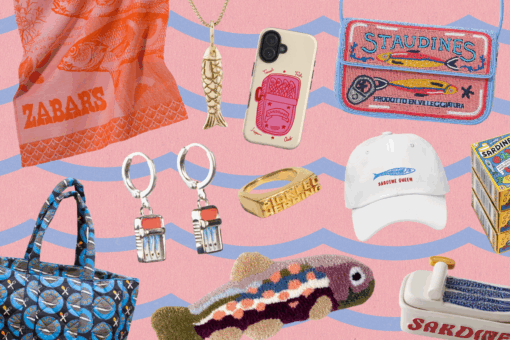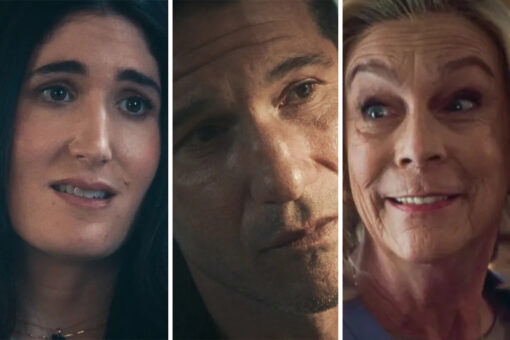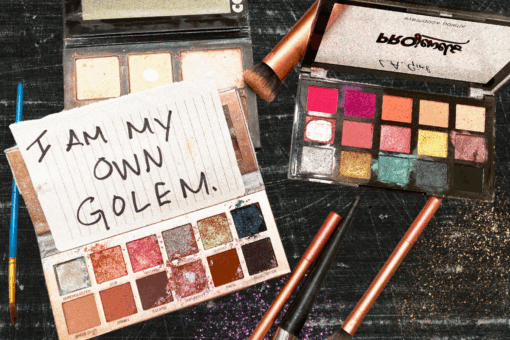Over the past two years, Vi has grown her fashion history YouTube channel, SnappyDragon, to over 85,000 subscribers, posting reviews of period drama costumes, medieval hair care routines, recreations of historical outfits and more. But when she realized how little, if any, information on Jewish fashion history existed in the blossoming historical costume community, she found herself eager to learn more, and bring Jewish representation and acceptance into this space. She wanted to engage with historical fashion in a way that acknowledged her Jewish identity, instead of separating herself from it. This meant creating new videos which focused on the historical dress and garments of Jewish communities, utilizing her background in dressing hair and her lifelong interest in research to bring historically accurate renditions to life.
For Vi, historical fashion is not just a passion, but a critically underexplored way for people to connect with their ancestors. Her new YouTube series, “The Clothes on Their Backs,” takes this interest to even more ambitious heights. Developed over six episodes, with funding and support from the Jewish Writers’ Initiative, “The Clothes on Their Backs” follows Vi through the process of recreating a Shabbat dress which might have been worn by Carolina, her great-great-grandmother who arrived in New York in 1881. The series delves into the design process — from choosing the right fabrics to finding antique buttons with Stars of David on them — to sewing the garments, getting dressed inside the Tenement Museum, and retracing Carolina’s steps around the Lower East Side.
Hey Alma caught up with Vi and the crew on the Lower East Side during a recent day of filming, in the dress she created for the series.
The series follows your process of learning more about your great-great-grandmother, Carolina. What made you feel connected to her?
She was who I would be in that time period. I think it’s a common experience for people to watch a historical drama or read a historical novel and identify with the character or picture themselves in that place. And for so much of my growing up, I would read these historical fiction books or watch period dramas and think, “Where are the Jews?” There’s no Jews! So if I want to identify with that character, I have to pointedly forget that I am Jewish and that matters. Thinking about someone like Carolina, I can sort of look and see, no, this is who I would have been. If I’m gonna put myself in that historical setting, that’s me. And that is really powerful, because it gives you a way to see yourself in history without having to separate yourself from these parts about your identity that matter to you.
Did your experience in sewing and dressmaking make it easier to connect with Carolina, who would have also spent her days sewing clothes?
I think because I know more about what it would have been like, I almost feel that I viscerally understand less. I don’t know what it’s like to sit in a factory for 12 hours a day, six days a week with a younger brother that I’m responsible for. I’ll never know what that’s like. But I do know what it’s like to be trying to get a dress done for myself on a deadline. And I know what it’s like to think, well, what would be the fast way to do this versus the right way to do this? I know what it’s like to sit at the sewing machine for several hours in a day, not 12, not an industrial sewing machine, not in a factory. But it gives me enough of a framework to be able to hear that and think, wow, that’s how intense that was. Even if I don’t know it, like in my chest, I can think about how my shoulders feel after three hours — and picture four times [that]. It’s not perfect, but it’s something.
You’ve spent the past few days walking around New York City in full historical garb. Does wearing the outfit help you better understand what it would be like to move in the world as a woman in the 1880s? How does it feel different?
Physically, it almost changes your posture. The way the shoulders are on this bodice, I need to hold my shoulders properly. As 21st century people, we lean forward. But if I do that, the back pulls and the front wrinkles up. So I have to have good posture. And under here, though this is the bit people always freak out about, I am wearing a corset. My waist is not any smaller. I don’t change size. It’s like a bra with back support. It’s not uncomfortable. I mean, it gets a little tiring after an entire day in it, but it’s not painful. I’m not laced to make my waist smaller. It’s just a base layer. But it changes your posture. I don’t lean back in the seat on the subway, I sit up straight. And even now, if I try to lean back, I’ll feel that’s not how the corset wants to sit. I have not been out of the house in 21st century clothes since Monday, and I’m comfortable. That’s the thing. As soon as I started putting it on, I was almost surprised by how at home instantly I felt it.
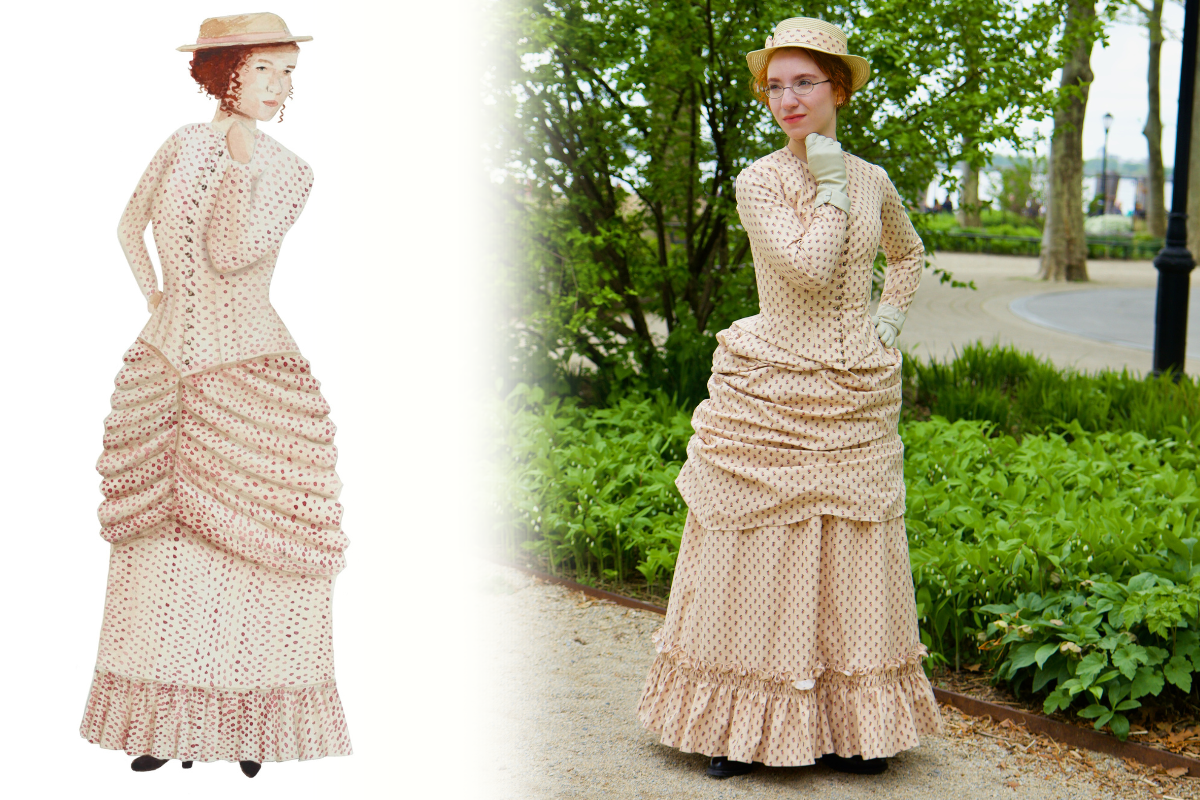
Can you describe what you’re wearing — what are all the layers?
My first layer is a chemise and drawers, meaning long bloomer underpants. Right now I’m wearing modern wool socks and lace-up boots. When I did the full costume for filming yesterday, I was wearing over-the-knee cotton stockings and boots that buttoned up. I’m not wearing them today because they hadn’t broken in enough and I started to blister a little bit, so I said nope, wear the lace-up boots, they’re not as common in this period but I can walk all day in these. Next up I’ve got the corset, which is plain white cotton. The boning is very light; it’s probably more flexible than my fingernails. It’s synthetic whalebone, which is a very similar material, but we don’t hunt whales like they’re a renewable resource anymore. So synthetic, not the real stuff.
There’s a bustle pad. This is 1881, before the big bustles were fashionable. Big bustles start getting fashionable again probably 1883 onwards, but a little pad to fluff the skirt out is fashionable, and that’s something you could make and stuff with fabric straps, which is what I did. So that’s just tied around the waist of the corset. I also have a petticoat, which is just a plain white cotton under skirt, just like the overskirt except it’s got a drawstring rather than waistband and hooks and eyes. It’s plain cheap fabric, easy to wash, because you want that to be the layer that gets dirty rather than the good fabric.
What I don’t have, and I should but I didn’t have time to make, is a corset cover. A corset cover is a little camisole which sort of smooths out the line of the corset under the top, and is another layer so the metal busk in your corset doesn’t wear on the good fabric of the dress.
How would Jewish fashion have looked different than other fashions that would have been worn at the time?
That is the question that threads its way through everything I do that is related to Jewish identity, because half the time we don’t know. There are some things I can point out. For example, I could say, sometimes very fashionable women would wear dresses in this period with a lower square neckline during the daytime. Carolina is probably not wearing that if she’s from an Orthodox community. If she’s Orthodox, when she gets married, she starts covering her hair; she’s not only wearing a hat anymore. If you’re working with wool, you got to be careful about your materials in a way that non-Jews don’t if you don’t want to end up wearing shatnez [mixing wool and linen, which is prohibited under Jewish law].
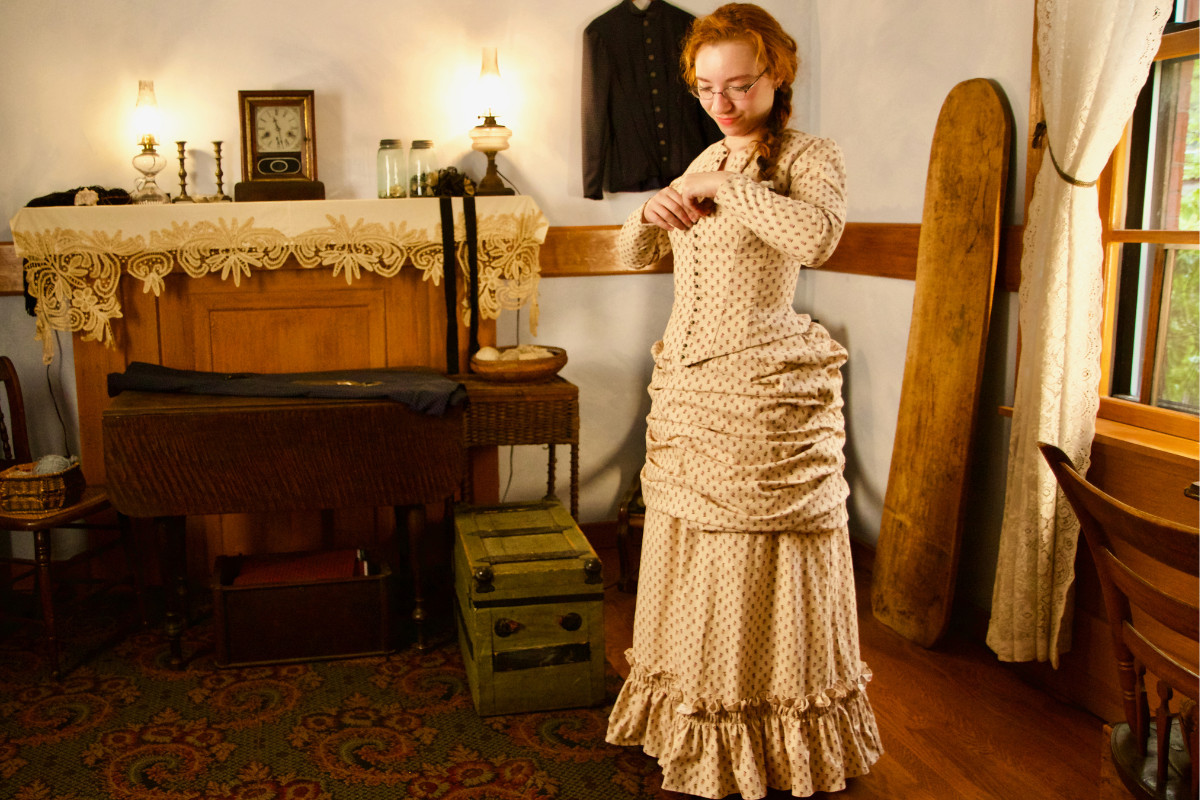
How did you come to choose Carolina as the central figure in this series?
I was looking at the ancestors on my mother’s side who had come over later — in 1904, I have a great aunt, in 1919 or 1920, my great-grandmother on that side came over — but those were time periods that have been more widely covered, with stories that I feel have been more covered. Then I traced my father’s side and found Carolina, my first female ancestor I could find on that side of my family.
I don’t have a relationship with my immediate family on my father’s side. That’s not something that’s possible or safe for me to have. And I was sort of looking at that and thinking, this is a way for me to get past the break in my relationship with that side of my family. There’s a lot I won’t be able to find out. I can’t speak to anybody on that side of my family about her. I won’t get a lot of personal stories. But how many people are going to be also struggling with the idea of connecting to their heritage, their family history, if they have some sort of break or difficulty in their relationship with their immediate family?
I talked it over with the fellows in my writers fellowship that are helping me produce this project, and I said maybe I just won’t mention it. And they said: No, you talk about it. Because you’ve got people in the audience that are thinking the same thing, and they want to hear about the experiences of getting past that.
What was it like to research Carolina’s story?
There’s nothing that’s ever going to be able to rebuild that connection with my immediate family on that side. But it does feel good to be able to look at that side of the family and say there are parts of my identity here that I don’t have to cut myself off from. Even if it’s through historical study, or through dressmaking rather than family stories and personal connection, I don’t have to throw the good out in order to set the boundaries I need to, which is a big thing. I think a lot of people struggle with feeling like either you have to stay in contact, even if that’s not healthy for you, or you have to completely cut off that whole part of your identity.
You are one of the few creators in the historical costume design world specifically telling Jewish stories. What has motivated that interest?
It feels very good to be able to step into what feels like a gap in the Jewish sphere, and it also feels like a very big thing to bring the Jewish perspective to the community of people that are interested in costuming and fashion history, but maybe are not seeing Jews represented in that area. I got a lot of those sorts of comments when I first talked about my Jewish identity on my YouTube channel. That was my first video to get a significant number of views and to really get circulated. And it was because people were saying: I’ve never seen anybody talk about Jewish fashion history, I’ve never seen anybody dress up in a medieval costume and talk about being Jewish in that time period. And certainly not in a way where they’re celebrating the identity rather than just talking about the antisemitism.

